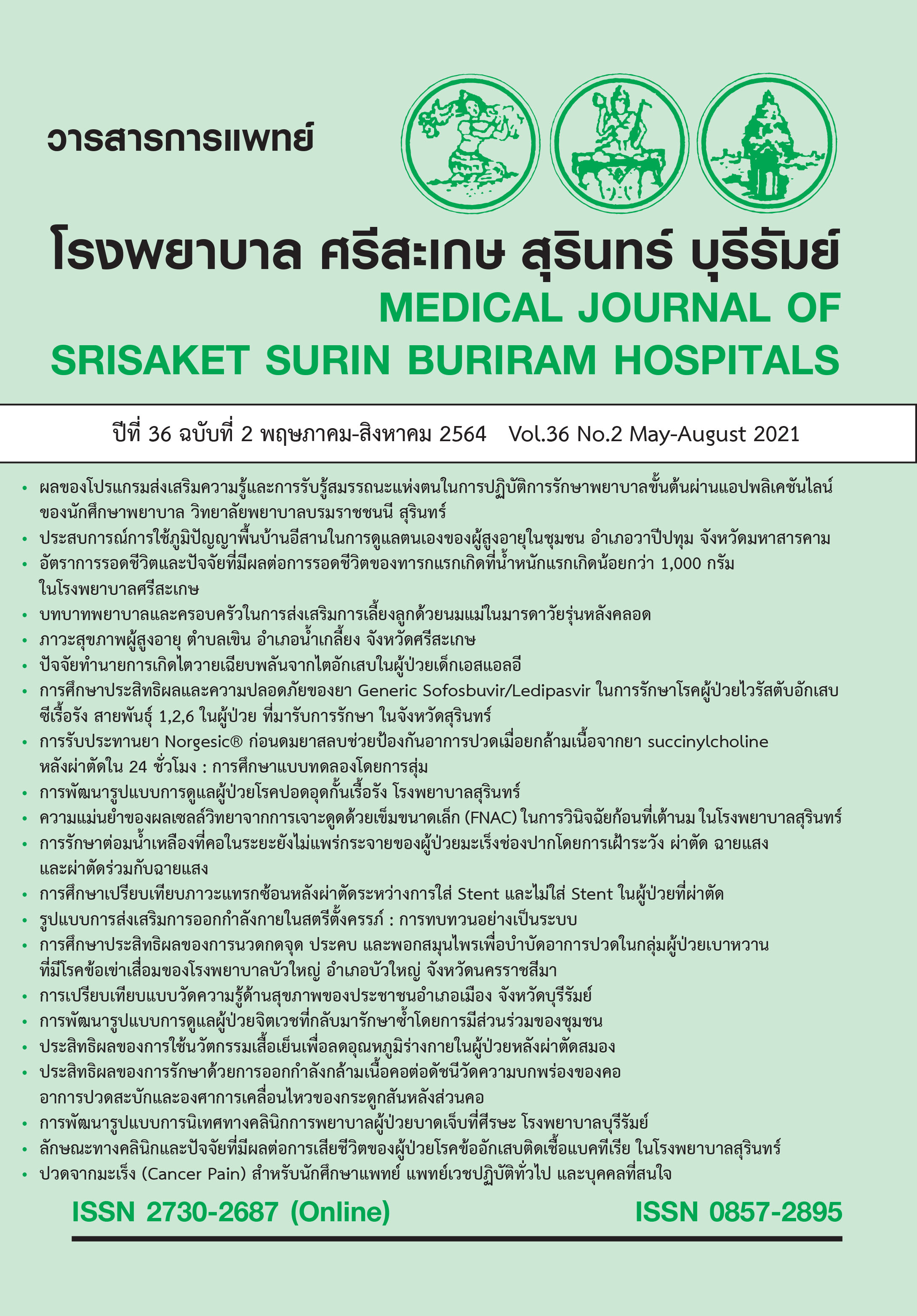อัตราการรอดชีวิตและปัจจัยที่มีผลต่อการรอดชีวิตของทารกแรกเกิดที่น้ำหนักแรกเกิดน้อยกว่า1,000 กรัมในโรงพยาบาลศรีสะเกษ
Main Article Content
บทคัดย่อ
หลักการและเหตุผล: ทารกแรกเกิดที่มีน้ำหนักน้อยกว่า 1,000 กรัม (Extremely low birth weight, ELBW) เป็นกลุ่มทารกที่มีอัตราการตายสูงมากและมักมีภาวะแทรกซ้อนของทารกคลอดก่อนกำหนด การศึกษาเพื่อหาปัจจัยในการรอดชีวิตในทารกกลุ่มนี้จะมีประโยชน์ในการช่วยพัฒนาศักยภาพในการดูแลรักษาทารกน้ำหนักน้อยให้มีอัตราการรอดชีวิตเพิ่มขึ้น
วัตถุประสงค์: เพื่อศึกษาการรอดชีวิตและปัจจัยที่มีผลต่อการรอดชีวิตในทารกแรกเกิดน้ำหนักน้อยกว่า 1,000 กรัมในโรงพยาบาลศรีสะเกษ
วิธีการศึกษา: รวบรวมข้อมูลจากเวชระเบียนผู้ป่วยในของทารกแรกเกิดน้ำหนักน้อยกว่า 1,000 กรัม (ELBW) ที่เข้ารับบริการในแผนกผู้ป่วยเด็ก โรงพยาบาลศรีสะเกษ ในช่วงปี พ.ศ. 2558– 2563 (5 ปี) ตั้งแต่แรกเกิดถึงจำหน่ายกลับบ้าน โดยรวบรวมข้อมูลประวัติมารดาและการคลอด รวบรวมจากใบบันทึกการคลอดของกลุ่มงานสูติ-นรีเวชกรรม โรงพยาบาลศรีสะเกษ
ผลการศึกษา: จำนวนทารกในการศึกษา 50 ราย มีอัตราการรอดชีวิตของทารกแรกเกิดน้ำหนักน้อยกว่า 1,000 กรัม (ELBW) ร้อยละ 42.2 สาเหตุการเสียชีวิต คือ respiratory distress syndrome (ร้อยละ 55.2) neonatal sepsis (ร้อยละ 34.5) pneumonia (ร้อยละ 6.9) birthasphyxia (ร้อยละ 3.4) ปัจจัยที่มีผลต่อการรอดชีวิตคือทารกเพศหญิง (HRadj=0.13,95%CI=0.04-0.40) น้ำหนักแรกเกิดมากกว่าหรือเท่ากับ 750 กรัม (HRadj=0.30 95%CI=0.09 - 0.95) ทารกที่เกิดจากมารดาที่ตั้งครรภ์น้อยกว่าหรือเท่ากับ 3ครั้ง (HRadj=0.05, 95%CI=0.01-0.29) Apgarscore ที่ 5 นาที 4–7 คะแนน(HRadj=0.06,95%CI =0.01-0.32) และ Apgarscore ที่ 5 นาที 8–10 คะแนน (HRadj=0.05,95%CI=0.01-0.32)
สรุป: ทารกแรกเกิดน้ำหนักน้อยกว่า 1,000 กรัม ในการศึกษาประมาณครึ่งหนึ่งรอดชีวิต โดยปัจจัยที่มีความสัมพันธ์กับการรอดชีวิตคือทารกเพศหญิง น้ำหนักแรกเกิดมากกว่าหรือเท่ากับ 750 กรัม Apgar score ที่ มากกว่าหรือเท่ากับ 4 ในนาทีที่ 5 ทารกที่เกิดจากมารดาที่ตั้งครรภ์ น้อยกว่าหรือเท่ากับ 3 ครั้ง
คำสำคัญ: อัตราการรอดชีวิต ทารกแรกเกิดน้ำหนักน้อยกว่า 1,000 กรัม ปัจจัยรอดชีวิต ปัจจัยเสี่ยง
Article Details
เอกสารอ้างอิง
Lim JW, Chung SH, Kang DR, Kim CR.Risk Factors for Cause-specific Mortality of Very-Low-Birth-Weight Infants in the Korean Neonatal Network. J Korean Med Sci 2015;30 Suppl 1(Suppl 1):S35-44. doi: 10.3346/jkms.2015.30.S1.S35.
Wise PH, Wampler N, Barfield W. The importance of extreme prematurity and low birthweight to US neonatal mortality patterns: implications for prenatal care and women's health. J Am Med Womens Assoc (1972) 1995;50(5):152-5. PMID: 7499702
Fanaroff AA, Wright LL, Stevenson DK, Shankaran S, Donovan EF, Ehrenkranz RA, et al. Very-low-birth-weight outcomes of the National Institute of Child Health and Human Development Neonatal Research Network, May 1991 through December 1992. Am J Obstet Gynecol 1995;173(5):1423-31. doi: 10.1016/0002-9378(95)90628-2.
Ross G, Lipper EG, Auld PA.Educational status and school-related abilities of very low birth weight premature children. Pediatrics 1991;88(6):1125-34. PMID: 1956729
Ross G, Lipper EG, Auld PA.Social competence and behavior problems in premature children at school age . Pediatrics 1990;86(3):391-7. PMID: 2388788
Steward DK, Pridham KF.Growth patterns of extremely low-birth-weight hospitalized preterm infants. J Obstet Gynecol Neonatal Nurs 2002;31(1):57-65. doi: 10.1111/j.1552-6909.2002.tb00023.x.
Hon KL, Liu S, Chow JC, Tsang KY, Lam HS, So KW, et al.Mortality and morbidity of extremely low birth weight infants in Hong Kong, 2010-2017: a single-centre review. Hong Kong Med J 2018;24(5):460-465. doi: 10.12809/hkmj177181.
Peterson SW.Understanding the sequence of pulmonary injury in the extremely low birth weight, surfactant-deficient infant. Neonatal Netw 2009;28(4):221-9. doi: 10.1891/0730-0832.28.4.221.
พิมลรัตน์ ไทยธรรมยานนท์,สันติ ปุณณะหิตานนท์. ภาวะแทรกซ้อนและการเสียชีวิตของทารกแรกเกิด น้ำหนักน้อยมากในโรงพยาบาลจุฬาลงกรณ์. จุฬาลงกรณ์เวชสาร 2551;52(4):255-64.
Hamilton KE, Redshaw ME, Tarnow-Mordi W.Nurse staffing in relation to risk-adjusted mortality in neonatal care. Arch Dis Child Fetal Neonatal Ed 2007;92(2):F99-F103. doi: 10.1136/adc.2006.102988.
Hillemeier MM, Weisman CS, Chase GA, Dyer AM. Individual and community predictors of preterm birth and low birthweight along the rural-urban continuum in central Pennsylvania. J Rural Health 2007;23(1):42-8. doi: 10.1111/j.1748-0361.2006.00066.x.
Kramer WB, Saade GR, Goodrum L, Montgomery L, Belfort M, Moise KJ Jr.Neonatal outcome after active perinatal management of the very premature infant between 23 and 27 weeks' gestation. J Perinatol 1997;17(6):439-43. PMID: 9447529
Rosner BR. Fundamentals of Biostatistics. 5th ed. United States: Cengage Learning, Inc; 2000: 384-5.
ดวงกมล เจริญเกษมวิทย์. อัตราการรอดชีวิตและปัจจัยเสี่ยงต่อการเสียชีวิตของทารกแรกเกิดน้ำหนักน้อยมากในโรงพยาบาลนครนายก วารสารไทยเภสัชศาสตร์และวิทยาการสุขภาพ 2551;3(1):87-96.
ภิญญดา แก้วปลั่ง. อัตราการรอดชีวิตและปัจจัยเสี่ยงต่อการเสียชีวิตของทารกแรกเกิดน้ำหนักน้อยมากในโรงพยาบาลสุรินทร์. วารสารการแพทย์โรงพยาบาลศรีสะเกษ สุรินทร์ บุรีรัมย์ 2554;26(3):379-92.
Eichenwald EC, Stark AR. Management and outcomes of very low birth weight. N Engl J Med 2008;358(16):1700-11
Lawn JE, Gravett MG, Nunes TM, Rubens CE, Stanton C; GAPPS Review Group.Global report on preterm birth and stillbirth (1 of 7): definitions, description of the burden and opportunities to improve data. BMC Pregnancy Childbirth 2010;10Suppl 1(Suppl 1):S1. doi: 10.1186/1471-2393-10-S1-S1.
Lemons JA, Bauer CR, Oh W, Korones SB, Papile LA, Stoll BJ,et al. Very low birth weight outcomes of the National Institute of Child health and human development neonatal research network, January 1995 through December 1996. NICHD Neonatal Research Network. Pediatrics 2001;107(1):E1. doi: 10.1542/peds.107.1.e1.
Ogawa M, Matsuda Y, Kanda E, Konno J, Mitani M, Makino Y, et al. Survival rate of extremely low birth weight infants and its risk factors: case-control study in Japan. ISRN Obstet Gynecol 2013;2013:873563. doi: 10.1155/2013/873563.
Lin HJ, Du LZ, Ma XL, Shi LP, Pan JH, Tong XM,.et al. Mortality and Morbidity of Extremely Low Birth Weight Infants in the Mainland of China: A Multi-center Study. Chin Med J (Engl) 2015;128(20):2743-50. doi: 10.4103/0366-6999.167312.


